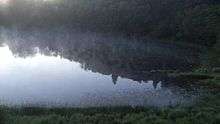Sea smoke


Sea smoke, frost smoke,[1] or steam fog,[2] is fog which is formed when very cold air moves over warmer water. Arctic sea smoke[3] is sea smoke forming over small patches of open water in sea ice.[4]
It forms when a light wind of very cold air mixes with a shallow layer of saturated warm air immediately above the warmer water. The warmer air is cooled beyond the dew point and can no longer hold as much water vapor, so the excess condenses out. The effect is similar to the "steam" produced over a hot bath or a hot drink, or even an exercising person.[2][3]
Sea smoke has a turbulent appearance and may form spiralling columns.[5] It is usually not very high and lookouts on ships can usually see over it (but small boats may have very poor visibility)[6] because the fog is confined to the layer of warm air above the sea. However, sea smoke columns 20–30 metres high have been observed.[5] Because this type of fog requires very low air temperatures, it is uncommon in temperate climates, but is common in the Arctic and Antarctic.[3]
References
[2] [3]; -webkit-column-width: [1] [2] [3]; column-width: [1] [2] [3]; list-style-type: decimal;">
- 1 2 3 Bowditch (1962). The American Practical Navigator. U.S. Navy Hydrographic Office. p. 614.
- 1 2 3 4 5 MacDonald, Edwin A., Captain, USN (Retired) (1969). Polar Operations. Annapolis: United States Naval Institute. p. 31.
- 1 2 3 4 5 6 Ministry of Defense (Navy) (1973). Admiralty Manual of Navigation, Volume II. London: Her Majesty's Stationery Office. p. 188.
- ↑ Mark Nuttall, Encyclopedia of the Arctic, p. 2163, Routledge, 2012 ISBN 1579584365.
- 1 2 H. U. Roll, Physics of the marine atmosphere, p. 359, Academic Press, 1965 ISBN 0080954448.
- ↑ Hank Halsted, "Fog", Motorboating and Sailing, pp. 41-42, August 1982 OCLC 46773002